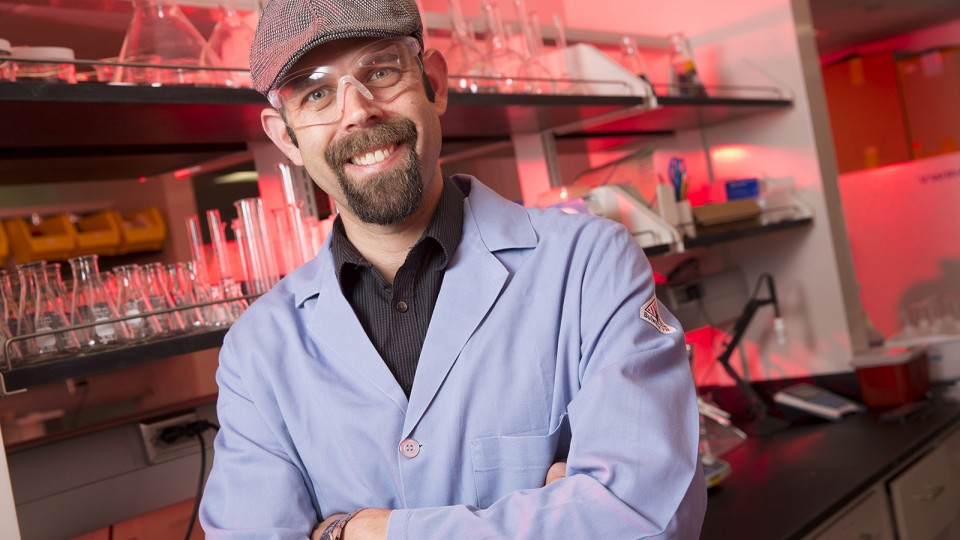· 5 min read
Morin, team show potential of ‘stretchable surfaces’

Building self-propelled, pharmaceutical-ferrying transports on the microscopic scale. Simplifying or even automating forensic processes. Stitching together patchwork nano-materials that expand the versatility of microelectronics.
Stephen Morin envisions a future in which the term “elastic demand” extends well beyond the world of economics. The chemist and his colleagues recently published research demonstrating how the chemistry of stretchable surfaces can affect their interactions with microscopic particles – and enhance or streamline processes usually conducted on rigid foundations.
In one study, Morin’s team investigated the interplay between chemical-coated silicone and microscopic crystals of various shapes. The team found that those shapes – discs vs. rods, for instance – largely determined the proportion of crystals that adhered to the silicone’s surface after stretching and relaxing the material several hundred times.
By coating distinct sections of the silicone with different molecules before stressing and releasing it, Morin and doctoral student Mark Rose also discovered that they could selectively separate crystals according to their shape. The ability to separate or even remove microscopic particles of various dimensions simply by stretching a material, Morin said, could prove especially useful in forensics.
“You may have a mixture of soil, fibers, shards of glass, or chips of paint or plastic,” said Morin, assistant professor of chemistry. “Trying to find a few (microscopic) chips of paint in a pile of soil isn’t easy.
“Imagine taking that random dispersion of particles, putting them onto this sensitive surface, letting some machine (stretch and relax it) repeatedly, and then, all of a sudden, your paint chips are still stuck to the surface but the soil is gone.”
Yet the same study also found that multiple classes of crystals adhered strongly to the silicone surfaces under a variety of conditions, whether simply exposed to air or submerged in a solution. That insight informed a subsequent paper that outlined a method for depositing and merging islands of microscopic particles on silicone surfaces. The team began by stamping patterns of polystyrene particles onto the silicone. To do so, the chemists ensured that the stamp’s exterior featured an attraction strong enough to pick up the particles but weak enough to release them when contacting the silicone.
After depositing the particles in polygonal groups about the width of a human hair and separated by roughly the same distance, the team treated them with a chemical vapor that effectively welded them into 900-particle islands. Stretching the silicone in one direction or another then brought the edges of those islands into contact, at which point the researchers again introduced the vapor to weld the adjacent islands into substantially larger groups.
Ultimately, Morin’s team assembled particles with a diameter 20 times smaller than a hair into structures that were millimeters in length – more than 1,000 times longer than an individual particle.
“I like to think of these rubber surfaces as two-dimensional assemblers,” Morin said. “By applying macroscopic stresses to the system, you can elicit microscopic control over (these) building blocks. As a concept, that’s really powerful.”
The team managed to extract those structures from the silicone while maintaining their structural integrity, a novel feat that Morin said could represent a “powerful contribution and advancement” in micromanufacturing. And the technique’s ability to dictate the size, shape and distribution of particle-based islands before maneuvering them into position could offer unprecedented control over the architecture and scale of resulting structures, he said.
That level of precision could even allow users to design and fabricate structures that feature different materials – along with chemical or electromagnetic properties – at strategic sites.
“That’s usually not possible using other directed-assembly methods, where you don’t have control over the composition of the building blocks,” said co-author Vinod Thavarool Puthiyedath, a postdoctoral researcher in chemistry.
“Additive manufacturing, like 3-D printing, is really big right now,” Morin said. “Those technologies are not only catching on in the research setting, but also in commercial and manufacturing settings. But those types of methods really struggle at very small size scales and … especially when you want to encode very specific functionality to the individual pieces.”
Morin, Puthiyedath and their colleagues illustrated this potential by incorporating materials that can catalyze chemical reactions when submerged in certain fluids or solutions. Some of those reactions expel gases that would produce thrust and, if the catalytic material were embedded on only one side of a microstructure, could potentially propel it through a biological system or other liquid environment.
“The ability to drive a specific reaction on a specific region of a surface could have wide-ranging applicability in analytical chemistry and biology,” Morin said.
The team also embedded materials that were tagged with fluorescent molecules. Arranging those molecules in unique patterns could enable the corresponding structures to act as microscopic barcodes, Morin said, helping researchers more easily identify them under the microscope or via visual tracking software.
Morin, Rose and Puthiyedath authored their recent studies with doctoral students Jay Taylor and Abhiteja Konda. The researchers published their findings in the journals Small and Chemistry of Materials, receiving support from the National Science Foundation and the 3M Company.








